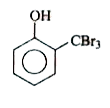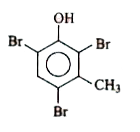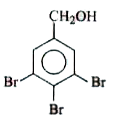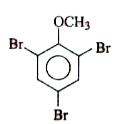Compound [X]C4H11N reacts with p− toluene sulphonyl chloride in aqueous NaOH to give a solid. The compound [X] is :
CH3−CH2−CH2−CH2−NH2
H3C−C∣CH3H−CH2−NH2
CH3CH2−NH−CH2−CH3
H3C−CH2−N∣CH3−CH3
The correct Answer is:D
To solve the problem, we need to identify the compound (X) with the formula C₄H₁₁N that reacts with para-toluene sulphonyl chloride in aqueous NaOH to yield a solid product. Here’s a step-by-step breakdown of the solution:
Step 1: Understand the Reactants
- The compound (X) has the formula C₄H₁₁N, indicating it is an amine.
- Para-toluene sulphonyl chloride (p-TsCl) is a reagent used to distinguish between primary, secondary, and tertiary amines.
Step 2: Identify the Type of Amine
- Primary amines (1°) have one carbon chain attached to the nitrogen (N) and two hydrogen atoms.
- Secondary amines (2°) have two carbon chains attached to the nitrogen and one hydrogen atom.
- Tertiary amines (3°) have three carbon chains attached to the nitrogen and no hydrogen atoms.
Step 3: Analyze the Reaction with p-TsCl
- Tertiary amines do not react with p-TsCl because they lack a hydrogen atom on the nitrogen.
- Primary and secondary amines will react with p-TsCl, forming sulphonamides.
- The question states that the reaction produces a solid product, which typically indicates that the amine is a secondary amine.
Step 4: Determine Possible Structures for C₄H₁₁N
- The possible structures for C₄H₁₁N can be:
1. Butylamine (1°)
2. Isobutylamine (1°)
3. Sec-butylamine (2°)
4. Tert-butylamine (3°)
Step 5: Eliminate Options
- Since tertiary amines do not react with p-TsCl, we can eliminate tert-butylamine.
- Both butylamine and isobutylamine are primary amines and would not yield a solid product with p-TsCl.
- This leaves us with sec-butylamine as the only candidate that is a secondary amine.
Step 6: Confirm the Product
- When sec-butylamine reacts with p-TsCl, it will form a sulphonamide which is a solid compound.
- Therefore, the compound (X) must be sec-butylamine.
Conclusion
The compound (X) is sec-butylamine.
---
- The compound (X) has the formula C₄H₁₁N, indicating it is an amine.
- Para-toluene sulphonyl chloride (p-TsCl) is a reagent used to distinguish between primary, secondary, and tertiary amines.
- Primary amines (1°) have one carbon chain attached to the nitrogen (N) and two hydrogen atoms.
- Secondary amines (2°) have two carbon chains attached to the nitrogen and one hydrogen atom.
- Tertiary amines (3°) have three carbon chains attached to the nitrogen and no hydrogen atoms.
- Tertiary amines do not react with p-TsCl because they lack a hydrogen atom on the nitrogen.
- Primary and secondary amines will react with p-TsCl, forming sulphonamides.
- The question states that the reaction produces a solid product, which typically indicates that the amine is a secondary amine.
- The possible structures for C₄H₁₁N can be:
1. Butylamine (1°)
2. Isobutylamine (1°)
3. Sec-butylamine (2°)
4. Tert-butylamine (3°)
- Since tertiary amines do not react with p-TsCl, we can eliminate tert-butylamine.
- Both butylamine and isobutylamine are primary amines and would not yield a solid product with p-TsCl.
- This leaves us with sec-butylamine as the only candidate that is a secondary amine.
- When sec-butylamine reacts with p-TsCl, it will form a sulphonamide which is a solid compound.
- Therefore, the compound (X) must be sec-butylamine.
The compound (X) is sec-butylamine.
Similar Questions
Knowledge Check
- Question 1 - Select One
The compound X(C7H9N) reacts with benzensulfonyl chloride to give Y(CH13H13NO2S) which is insoluble in alkali. The compound X is:
A B
B C
C D
D
- Question 2 - Select One
Compound (X) C4H8O, which reacts with 2,4-DNP derivative and gives negative haloform test is :
ACH3−O∣∣C−CH2−CH3BCH3−CH∣CH3−CHOC DCH3−CH2−OH∣CH−CH3
DCH3−CH2−OH∣CH−CH3 - Question 3 - Select One
Compound (A) C7H8O is insoluble in aqueous NaHCO3 and dissolves in aqueous NaOH and gives a characteristic colour with neutral FeCl3 . When treated with Br2 (A) forms compound (B) C7H5OBr3 .
The structure of compound (B) would be :A B
B C
C D
D
The compound X(C7H9N) reacts with benzensulfonyl chloride to give Y(C13H13NO2S) which is insoluble in alkali. The compound X is-
View SolutionGive the structure of (A) (explanations are not required). A(C3H9N) reacts with bezenesulphonyl chloride to give a solid insoluble in alkali'.
View SolutionAn optically active compound [A] C5H13N reacts with alkaline CHCl3 to give an optically active, compound [B]. [A] also reacts with nitrous acid to give an optically inactive alcohol [C] C5H11OH as the major product. What would be the structure of [A]?
View SolutionA compound A having molecular formula (C3H9N) on treatment with benzenesulfonyl chloride gives an insoluble solid. Identify A
View SolutionCompound (A) C7H8O is insoluble in aqueous NaHCO3 and dissolves in aqueous NaOH and gives a characteristic colour with neutral FeCl3 . When treated with Br2 (A) forms compound (B) C7H5OBr3 .
The most probable structure of compound A is :View Solution

